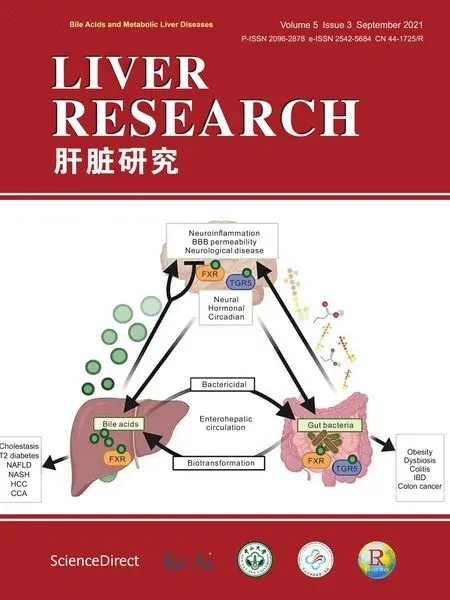Bile acid metabolism and bile acid receptor signaling in metabolic diseases and therapy☆
2021-12-03JohnY.L.Chiang,StefanoFiorucci
Bile acids are nutrient sensors and metabolic regulators that control nutrient intake and gut bacteria growth to regulate glucose,lipid,and energy homeostasis.Dysregulation of bile acid metabolism causes dysbiosis leading to obesity,diabetes,and liverrelated diseases.Bile acids and their derivatives have emerged as therapeutic drugs for treating liver metabolic and cholestatic diseases,type 2 diabetes,and non-alcoholic steatohepatitis (NASH).This special issue covers five emerging topics in bile acid research in metabolic diseases:(i)bile acid synthesis and metabolism in liver metabolic diseases;(ii) bile acid-activated receptors and signaling in liver metabolism and diseases;(iii)gut microbiome in liver pathophysiology and cholestasis;(iv)bile acid metabolism in metabolic gastric surgery;and(v)cholestasis-associated renal injury,disease,and therapy.
This special issue has five review articles written by experts in bile acid research.Ferrell and Chiang1reviewed bile acid metabolism and bile acid-activated receptor farnesoid X receptor (FXR)and Takeda G protein-coupled receptor 5 (TGR5) signaling in the liver,gut,and brain axis.FXR and TGR5 are expressed in the gastrointestinal tract,where bile acids are synthesized,circulated,and reabsorbed,to play critical roles in nutrient absorption and distribution,metabolism,and regulation of not only bile acid and lipid homeostasis,but also glucose and energy metabolism in the gut to liver axis.These receptors also are expressed in the brain,the organ involved in steroid metabolism and control apatite and metabolism in the liver and intestine.Their roles in brain metabolism and functions and neurological diseases have just been uncovered in recent years.This review discusses the role of FXR and TGR5 in neuro-steroid synthesis,drug transport,circadian rhythm,antiinflammation,and neurological diseases including Alzheimer's disease,Parkinson's disease,and hepatic encephalopathy.
Biagioli and Fiorucci2reviewed bile acid receptors in integrating immune and metabolic regulation in non-alcoholic fatty liver disease (NAFLD).Liver metabolic disorders have an inflammatory component and regulation of liver/intestinal immunity might be part of the beneficial effects of bile acid-based therapies.The multifactorial mechanisms of pathogenesis of cholestatic liver disease and NAFLD are complex and not completely understood.This review focuses on liver immune systems that are activated in response to liver injury and the mechanisms of FXR and G protein-coupled bile acid receptor 1 (GPBAR1,also known as TGR5) agonists in anti-inflammation in the liver and intestine.The liver to gut axis and adipose tissue to liver axis are involved in immune cell crosstalks in bile acids and receptors signaling.Pre-clinical and clinical trials of FXR and TGR5 agonists for NASH therapies are updated.
Maliha and Guo3reviewed FXR and fibroblast growth factor 19(FGF19) as pharmaceutical drugs targeting NASH.FXR agonists and antagonists in clinical trials for primary biliary cirrhosis and NASH were described in detail.FGF19 is a down steam signal of intestinal FXR that has been shown to inhibit bile acid synthesis,reduce inflammation,and promote energy metabolism in experimental NAFLD models.An FGF19 analogue devoid of tumorigenic effect in clinical trials was described in this review.
Yan and Yin4reviewed the role of gut microbiota in liver pathophysiology and cholestatic liver disease.The gut-liver axis contributes to liver inflammation and injury in alcoholic fatty liver disease and NAFLD.This review covers gut microbiome and bile acid metabolism in cholestatic liver diseases,including primary biliary cholangitis and primary sclerosing cholangitis (PSC),and potential therapeutics including fecal transplantation,antibiotics,probiotics,and prebiotics on remodeling of gut microbiome and diseases.
Xu.et al.5reviewed bile acid signaling in metabolic surgery for obesity,which rapidly improves glycemic control and insulin resistance even before losing weight in overly obese patients.This review explores potential mechanisms of gastric surgery in improving metabolism via bile acid-activated FXR and TGR5 signaling.Understanding the underlying molecular mechanisms of metabolic surgery is important for designing non-invasive therapy for obesity and metabolic diseases.
Two original articles by Ommat.et al.6,7reported studies of metformin action in oxidative stress and mitochondrial function for treating cholestasis-associated nephropathy in experimental models,and edaravone as a drug therapy targeting oxidative stress and mitochondrial function for alleviation of cholestasis-associated hepatic and renal injury.Metformin is the first line drug for managing blood glucose and diabetes for many decades,but the mechanisms of metformin in anti-diabetes are complex,not completely understood.Metformin improves mitochondria functions to reduce oxidative stress,which contributes to improving insulin sensitivity in diabetic patients.These two articles focused on the mechanisms of drugs therapy targeting to treat nephropathy and renal injury associated with cholestasis.
Collections in this special issue cover translation of basic research in bile acid mechanism and bile acid signaling to drug therapies targeting metabolic liver diseases,and pre-clinical animal studies to phase II and phase III clinical trials of bile acid-based therapy for cholestatic liver diseases and metabolic liver diseases.Several bile acid-based drugs are currently in development for treating cholestatic liver diseases.Many bile acid-based drugs are in II and III phases clinical trials for NASH.It is anticipated that several of these drugs,in combination with drugs targeting lipid metabolism,will be approved for NASH in the coming years.
Authors’ contributions
J.Y.L.Chiang and S.Fiorucci wrote the manuscript.
Declaration of competing interest
The authors declare that they have no conflict of interest.
Acknowledgements
This manuscript is supported by the USA National Institutes of Health (NIH) grants DK44442 and DK58379 (J.Y.L.Chiang) and a grant from MIUR,Italy PRIN 2017:2017FJZZRC (S.Fiorucci).
杂志排行
Liver Research的其它文章
- Gut microbiome in liver pathophysiology and cholestatic liver disease☆
- Mitigation of cholestasis-associated hepatic and renal injury by edaravone treatment:Evaluation of its effects on oxidative stress and mitochondrial function☆
- Metformin alleviates cholestasis-associated nephropathy through regulating oxidative stress and mitochondrial function☆
- Bile acids and metabolic surgery☆
- Farnesoid X receptor and fibroblast growth factor 15/19 as pharmacological targets☆
- Bile acid activated receptors:Integrating immune and metabolic regulation in non-alcoholic fatty liver disease☆
